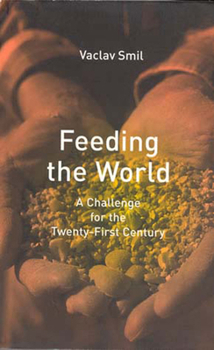Feeding the World
Select Format
Select Condition 
Book Overview
A realistic yet encouraging look at how society can change in ways that will allow us to feed an expanding global population. This book addresses the question of how we can best feed the ten billion or so people who will likely inhabit the Earth by the middle of the twenty-first century. He asks whether human ingenuity can produce enough food to support healthy and vigorous lives for all these people without irreparably damaging the integrity...
Format:Paperback
Language:English
ISBN:0262692716
ISBN13:9780262692717
Release Date:October 2001
Publisher:MIT Press
Length:390 Pages
Weight:1.18 lbs.
Dimensions:0.9" x 6.3" x 9.1"
Age Range:18 years and up
Grade Range:Postsecondary and higher
Related Subjects
Agricultural Sciences Agriculture Earth Sciences Economics Engineering Environment Environmental Economics Environmental Science Environmental Studies History Industries & Professions Information Management Politics & Government Politics & Social Sciences Public Affairs & Policy Science Science & Math Science & Scientists Science & Technology Social Science Social Sciences Social Services & Welfare Technology TextbooksCustomer Reviews
1 rating
When to Be Optimistic
Published by Thriftbooks.com User , 23 years ago
Smil's book is a "must read" for anyone interested in the world food problem. His most valuable contribution is his insistence, backed up with an unparalleled marshalling of facts, that the biggest hope in the short run lies in greater efficiency. By looking at the whole food cycle, from field to final end, he can show (correctly) that waste all along the line is costing us more than enough food to feed all the hungry AND many of the unborn. Water and fertilizer are lost in the field, grain goes to rats and weevils during storage, and so on down to the appalling plate waste in the US. Smil does not side with the catastrophists who project imminent famine (they have been wrong too often) nor with the cornucopians who see nothing but plenty ahead (he dismisses them with the tart comment that, ultimately, the earth would have to be all grain if food and population kept growing). He is, however, on the optimistic side, seeing existing and fairly easily-developed technology as quite adequate to feed the expected world population. There are some problems. First, he accepts the hopeful premise that world population will level off around 10 billion. In spite of the mantra-like repetition of this figure by aid agencies, it is probably too optimistic. China is barely managing to sustain its one-child policy, and population growth is still rapid in the Middle East, South Asia, Africa, and Latin America; many countries show no sign of slowing. Second, he adopts the most optimistic possible figures or scenarios on soil erosion and some other variables. Desertification, for instance, he ascribes largely to natural climatic swings. This is not credible; there are far too many photographs, from around the world, of desertification that stops short at barbed-wire fences (which prevent overgrazing). On the other hand, he does not say much about minor and obscure crops, and still less about obscure cropping regimes and methods. Use of such technologies (found mostly among traditional peoples around the world) could vastly increase the productivity of world agriculture. One notes, going beyond this book, that some countries today are as badly off as the most pessimistic of catastrophists feared: Sudan, Ethiopia, Afghanistan, Nicaragua, Mali, and many more. These are countries with weak and usually tyrannical governments, often torn by conflict. Conversely, some countries have done as well as the most cheery optimists could have hoped; these are mostly European countries with strong, democratic governments with high levels of accountability. In between, countries fall neatly into line along a continuum. China, Smil's and my main area of expertise, is in the stretch. Smil, arguing against Lester Brown, sees much hope for China. However, China's government is currently toward the weak and tyrannical end, making Lester Brown's gloomy predictions look more reasonable. China has a long history of saving itself at





